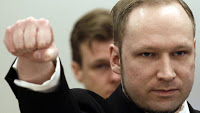is the third day of Anders Behring Breivik’s trial for the shocking
murders of 77 people in Norway last July, and prosecutors have been
questioning the ultra-nationalist terrorist about his associates in the
radical counter-Jihad movement.
we should raise further troubling questions, and ask: could there be
powerful individuals and criminal political networks operating above Breivik, who enabled his brutal attack, in order to further their own agendas?
Breivik,
in his 1500-page manifesto, and in statements given to the police,
claimed to be part of an organisation called the “Knights Templar”,
which he says has cells across Europe who are ready to commit similar
atrocities in their war against “cultural Marxists” and Islamic
immigration. Whilst Breivik has admitted creating an exaggerated image
of the network, describing the manifesto and his wearing of a uniform in photos as a deliberately “pompous” “sales tool”, he has been insistent that the network really exists. He says that its four founding members met at an inaugural meeting in London in 2002 (his presence in London at the time having been confirmed by a credit card receipt), and that the network now consists of “more than 15 people”,
with numbers of up to 80 claimed in his manifesto. Breivik warned today
that there are two cells in Norway, capable of carrying out attacks
similar in scale to his own.
Norwegian authorities say they have found no evidence to support Breivik’s claims, with prosecutor Svein Holden telling the court on
Monday that “In our opinion, such a network does not exist”. Their
position appears to have shifted slightly in the last couple of days,
with prosecutors now saying that a network does exist, albeit not “in the way he describes it.”
Something that is not disputed is the fact that the Norwegian intelligence service (the PST) were aware of Breivik months prior to his attack; his name had been on a watch list, but the PST had
failed
to follow up on a tip about…Breivik’s acquisition of materials that
could be used to produce explosives. PST also came under criticism for
failing to pay enough attention to Norway’s right-wing extremist groups,
and failing to pick up any suspicions about Breivik.
The PST say that they did not act on the information because they did not think it “relevant”; Breivik regrettably “slipped
through the net”, a predictably standard excuse that we have seen
offered many times by other intelligence services following successful
terror attacks – after the 7/7 London bombings, for example, and more
recently following Mohamed Merah’s murder spree in Toulouse.
 There
There
have also been reports of contact between Breivik and other European
intelligence operatives. Though unsubstantiated, a Belarusian opposition
politician claimed that Breivik received paramilitary training from a former special service officer in Belarus.
Whilst
there is not enough evidence to make any firm assertions about whether
or not Breivik was indeed being “handled”, the case very much brings to
mind the widely-documented state-sponsored terror operation known as
“Gladio”. Operation Gladio, also
called the “strategy of tension”, was a clandestine European-wide NATO
“stay behind” operation launched after the end of the second world war,
and which ran for decades.
Its aim was to prevent Communism from gaining
a foothold in Europe, and far-right militants in various countries were
given funding, weapons, and explosives by state security services, with
which they were encouraged to commit domestic terror attacks.
These
attacks were classic “false flags”, blamed on left-wing and Communist
parties, politicians, and sympathisers, serving to create widespread
fear, and turning domestic populations against those espousing leftist
political ideologies and towards the supposed protection of the state –
ensuring the continued power of the controlling elite. Operation Gladio
is not a “conspiracy theory”; it was admitted to the Italian senate by
prime minister Giulio Andreotti in 1990, when The Observer newspaper described the revelations as the “best kept, and most damaging, political-military secret since World War II”.
Many
innocent people were murdered during Operation Gladio. The Bologna
train station bombing of 1980 killed 85 and wounded more than 200. The
“Brabant massacres” in Belgium during the early 1980s, when 28 people
died during indiscriminate shootings at restaurants and supermarkets,
are also believed to have been part of the murderous “strategy of
tension”.
Whilst
we cannot make any definite assertions, it is certainly a possibility
that Breivik’s attack was similar in nature to Operation Gladio – a
covert elite-sanctioned atrocity designed to ratchet up tension, and
instill shock and fear in the Norwegian population, and amongst the
population of Europe more widely. Fear and disorientation can be
exploited by those in control and used by such rogue elites, operating
outside the publicly visible political sphere, to further consolidate
power.
Professor Peter Dale Scott has characterised Breivik’s
attack as “systemic destabilisation”, a “deep event” influenced by, and
furthering, the agendas of a shadow elite.
 Rather than such dark forces
Rather than such dark forces
working “in the structures of the state itself”, however, Scott looks
to “the demi-monde mobilized outside and against the state” –
and in particular, to international drugs and arms networks.
Scott
perceptively notes that the video Breivik released onto the internet immediately before his attack bears striking similarities to a video made
by the German anti-Jihadist Nick Greger, and that most of the
“Christian freedom fighters” featured in Greger’s video “are united, not
by ideology, but by their involvement in the lucrative arms-for-drugs
traffic” – with six having been directly identified as drug traffickers.
States Scott:
It
is not surprising that Greger’s militia leaders should become
traffickers: illicit paramilitaries usually have to acquire and pay for
their arms through illicit arms-for-drugs networks. The video’s line-up
of Christian drug traffickers reminds us of the current symbiosis
between non-state violence (whether that of revolutionaries or of
militias hired to fight them) and the drug traffic: the drug traffic now
thrives where there is non-state violence, and those involved in such
violence (whether of the right or left) support themselves by drugs.
Today the global maps of major drug-growing and of non-state violence
are virtually one and the same.
Scott
concludes by suggesting that to identify those who may have enabled
Breivik’s attack, we might look “beyond the parastatal structures of
nations (including the CIA) to a more unstructured and paranational deep
force or dark force, or forces, colluding with, and sometimes perhaps
manipulating, these parastatal structures”.
Breivik
is scheduled to stand trial for his terrible crimes for the next 10
weeks. During that time, more evidence will hopefully be revealed that
can help shed light on such troublingly plausible theories; theories
that will no doubt be dismissed by some as ridiculous, even obscene, but
which, given the many proven examples of the murderous capabilities of
powerful criminal elites, are certainly worthy of consideration and
research.
This article first appeared at Resistance Radio.
Brit Dee runs an independent online radio station called Resistance Radio, which broadcasts daily news, views and analysis challenging the lies of our corrupt political and financial leaders, and the controlled corporate media, at http://www.resistradio.com.
var linkwithin_site_id = 557381;
linkwithin_text=’Related Articles:’


Be the first to comment on "Anders Behring Breivik: Shades Of Gladio, ‘Deep Events’"